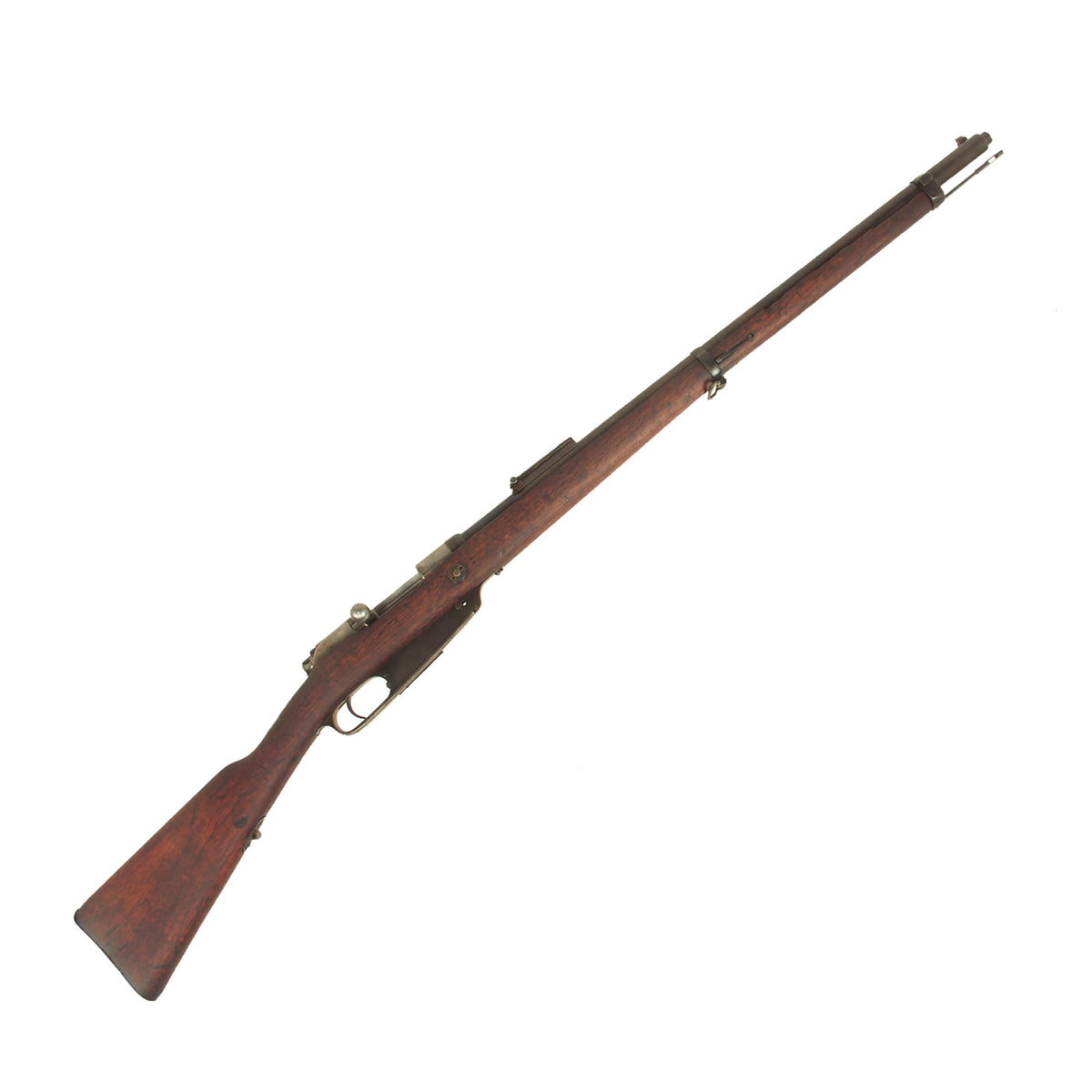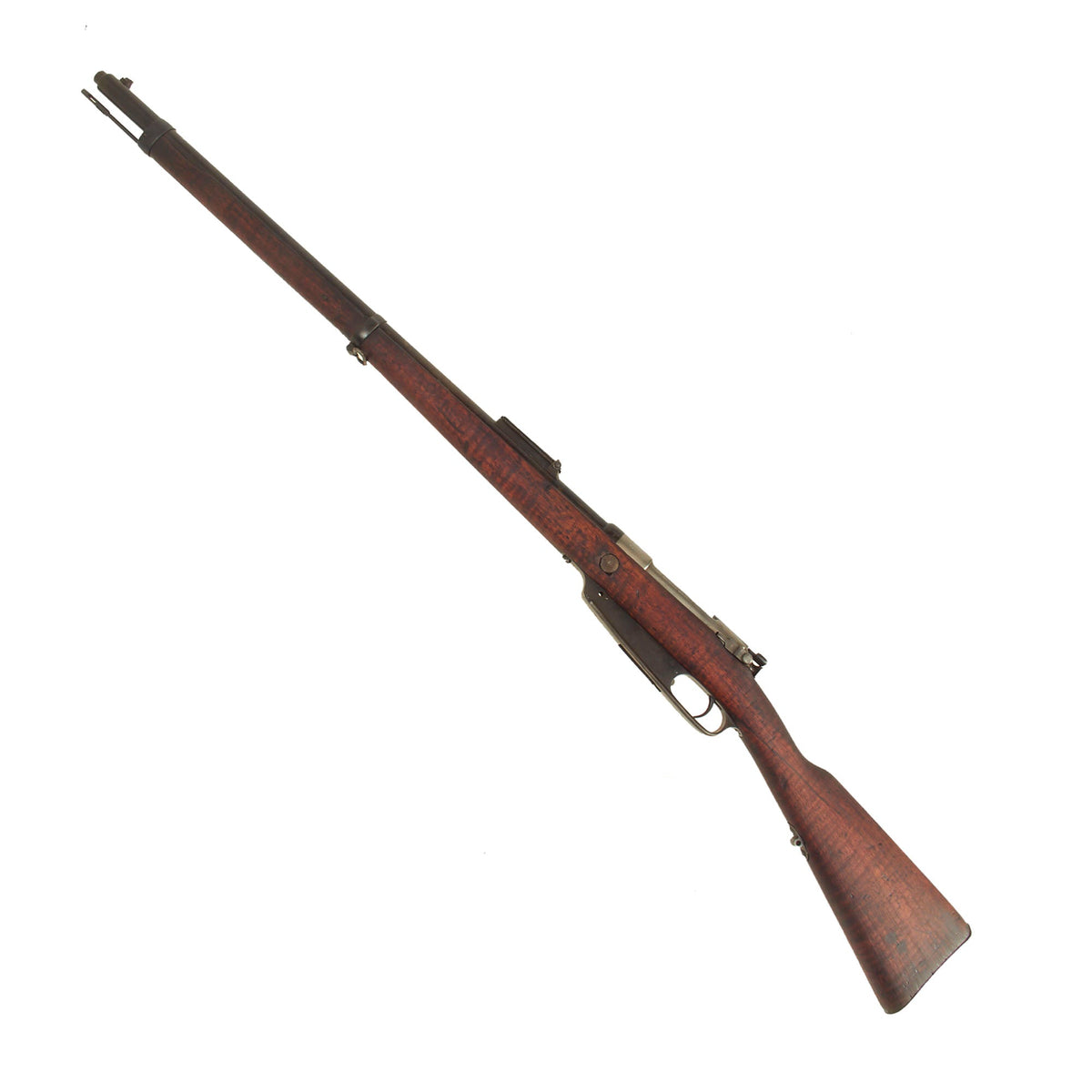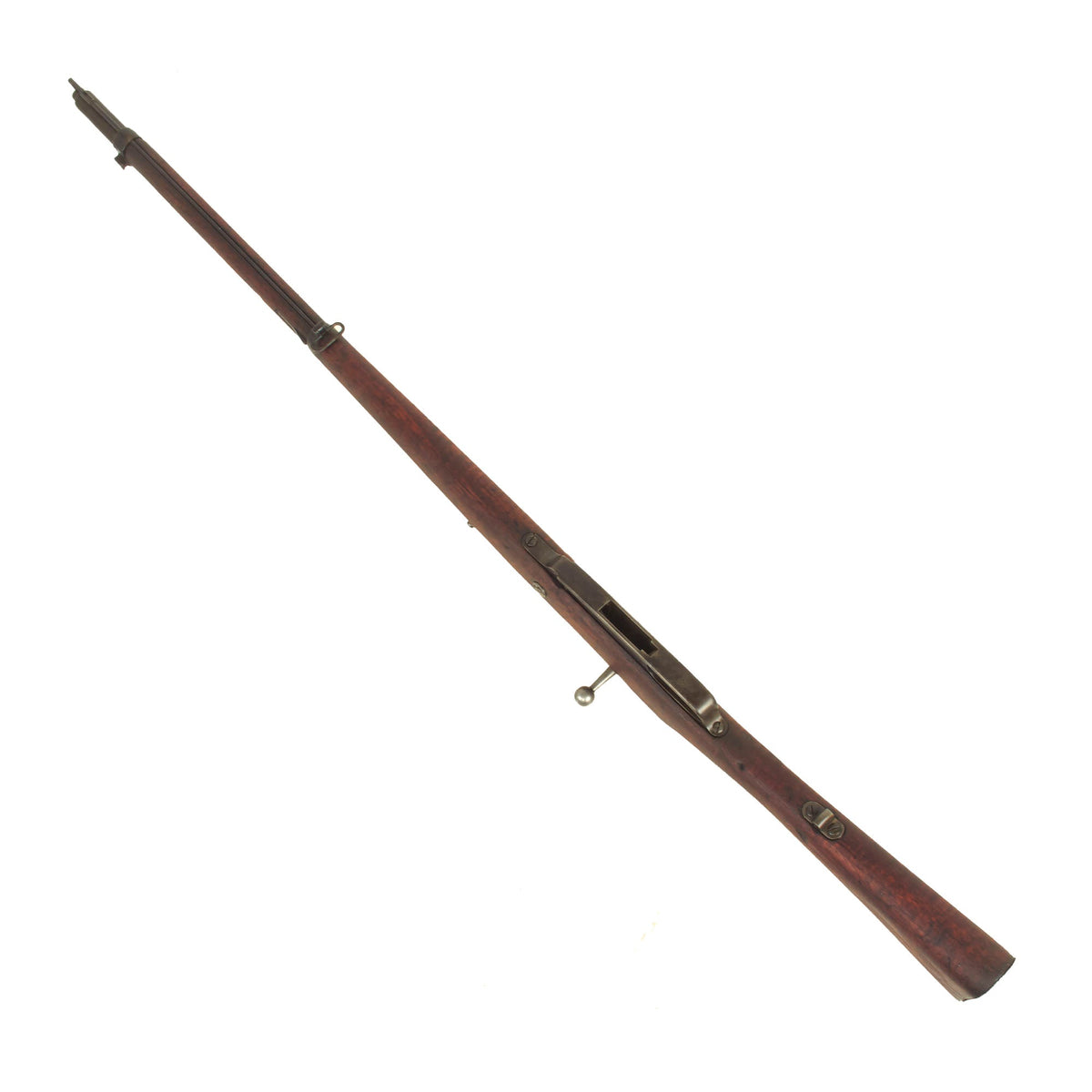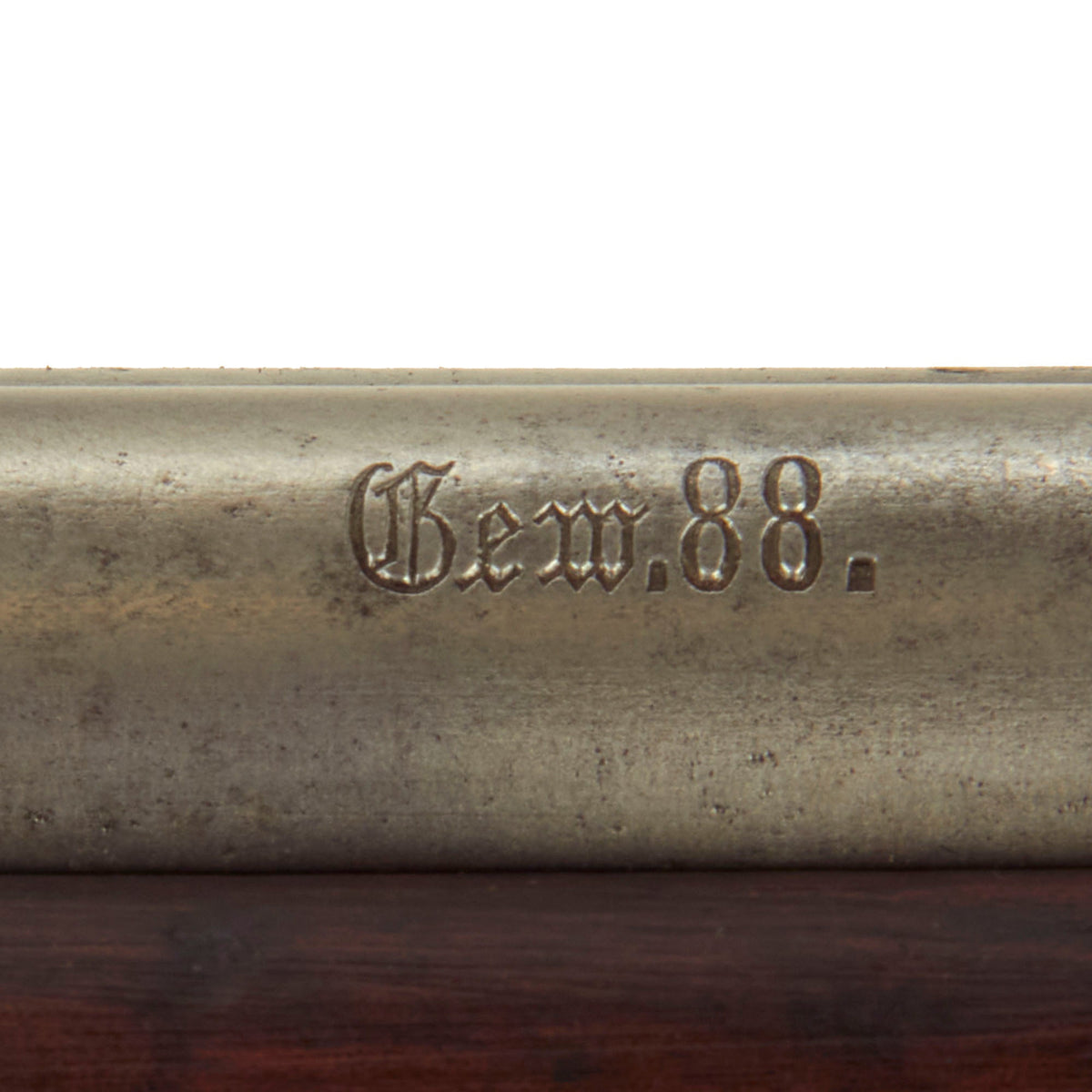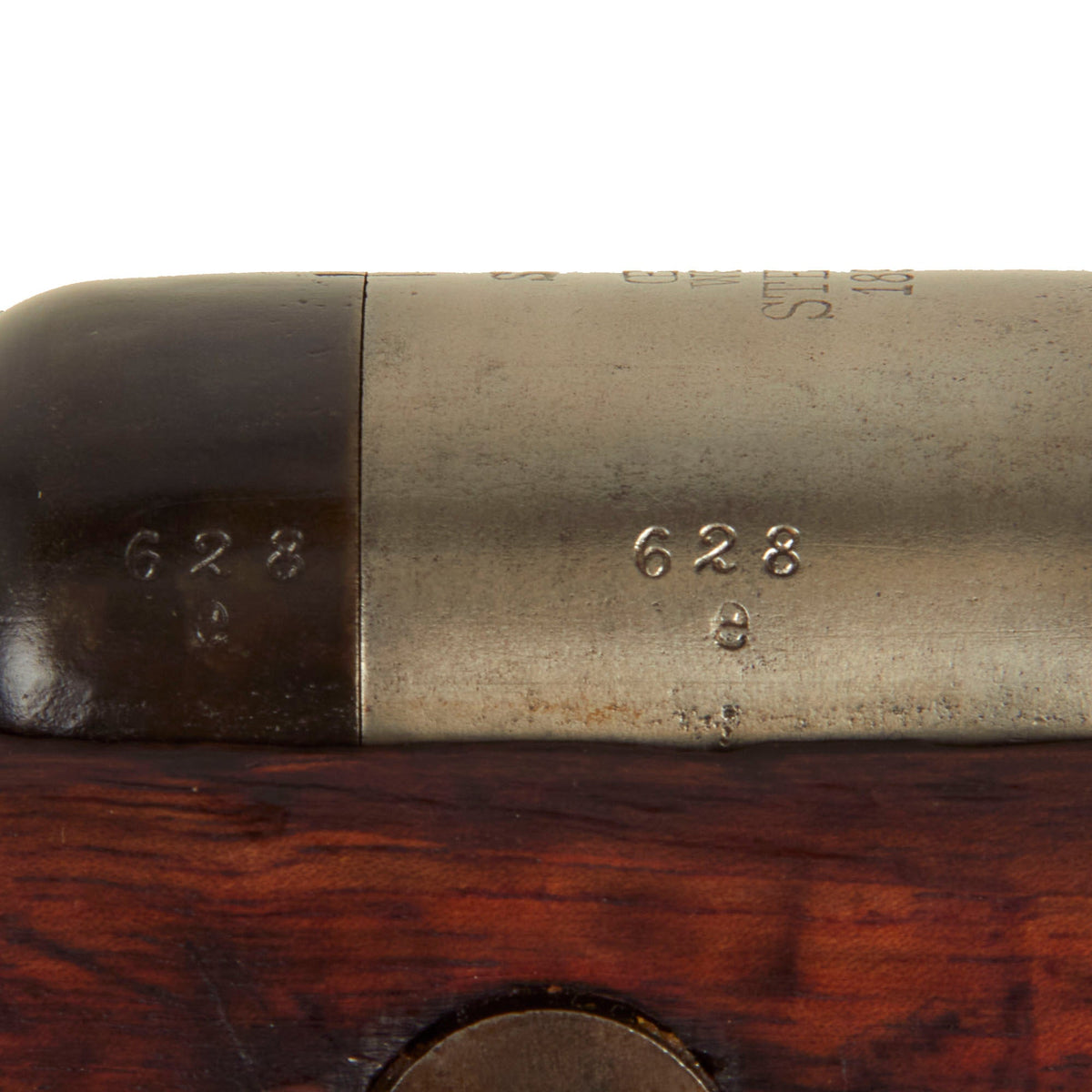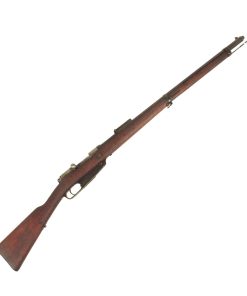Original German Pre-WWI Gewehr 1888 Commission Rifle by ŒWG Steyr Serial 628 ewith No Turkish Markings – Dated 1890 Original Items
$ 895,00 $ 223,75
Original Item: Only one Available. This is a very nice example of the iconic German Gewehr 1888 “Commission Rifle”, also known as the Gewehr 88, or GEW 88. It was manufactured by the famed Steyr Mannlicher firearms division of Österreichische Waffenfabriksgesellschaft (ŒWG, Austrian Arms-Manufacturing Company) in Austria. The rifle then saw long service, as indicated by the large number of different markings on the gun. It definitely looks to have been reconditioned at arsenal, where parts were often replaced with those from other rifles. However, it does not have any export markings from Turkey or other countries, so this was never shipped off as WWI aid. We very rarely see these rifles in this configuration!
The rifle still bears one original German regimental designation, stamped on the upper barrel band / nose cap: K. E. R. 9. 129.. Research indicates this should be for the Königin Elisabeth Regiment, otherwise known as the 3rd (Queen Elizabeth) Guards Grenadiers Regiment, first raised 5 May 1860 and Garrisoned in Charlottenburg. The rest of the designation indicates it is for the 9th Squadron, Weapon 129. This is a front line unit, not a reserve unit, so this was probably added early in the barrel band’s service life.
These rifles were originally chambered for 7.92mm Patrone 88 ammunition and had a fixed magazine. Virtually all Gewehr 88 rifles in service were converted to take the 7.92×57mm Mauser S Patrone, and has an S stamped above the chamber, indicating the conversion. The Spitzer-shaped S Cartridge was ballistically superior to the M/88, however the chamber required modification to accept the thicker walled shell casing. There is also not a notch at the front of the receiver, and it has no stripper clip guides, so it was not converted after 1905 for Gew 98 Mauser clips. The design of these clips necessitated making a notch in the front receiver, so the cartridge tips would clear it.
The right side of the receiver is correctly marked Gew. 88. in German blackface type and also has serial number 628 / e on the receiver and barrel jacket. The other parts are all un-matching, typical for a rifle that was serviced at arsenal. Over the chamber it is clearly marked Π/ WG / STEYR / 1890, for manufacture by Steyr in Austria.
Rifle is in very good service used condition, and looks to have been reconditioned at arsenal, which has completely removed the original stock cartouches. It shows a lovely finish and red brown color, with some staining and other wear consistent with long service. There is also a pinned repair through the wrist of the stock, and some wood filler in places, as well as a missing chunk along the woodline on the right side muzzle. However, the stock is also made over very attractive “tiger flame” figured wood, so it looks great, in spite of the deficiencies.
The receiver and bolt still show the original bright steel finish, with some light oxidation and past peppering in areas of the receiver. The barrel jacket now has a gray mottled look, having lost some of the original finish. We do not see any denting or other damage to the barrel jacket, however the rear sight mounted to it is missing the slider.
There is some wear on the bolt bearing surfaces, and some areas of light oxidation staining on the bolt. However, the bore is in very good condition with crisp lands and grooves and a mostly bright finish. It looks to have seen only light use during service. The bolt extractor, which is easily lost during cleaning, is still present, as is the rare double slot cleaning rod. The rifle cycles and dry fire well, and the firing pin is intact.
An absolutely genuine GERMAN M-1888 Service Rifle, issued to a German Infantry Regiment. Almost all of these were later updated to the 88/05 S standard, so finding one that was not updated or shipped to Turkey as aid is very rare. Fully cleaned and ready to research and display!
Specifications-
Year of Manufacture: 1890
Caliber: 7.92×57mm Mauser
Cartridge Type: Centerfire Cartridge
Barrel Length: 29 inches
Overall Length: 49 Inches
Action type: Bolt-Action
Feed System: 5 round internal magazine
History of the Gewehr 88
In 1886, the French Army unveiled the Modelle 1886 “Lebel” rifle. There was an immediate reaction in German military circles bordering on hysteria. Why? Because the Lebel was the world’s first small bore military rifle using an efficient smokeless powder cartridge. Now, the Lebel, which used a tubular magazine located under the barrel was not a particularly noteworthy design, but the power and flat trajectory of the new French 8mm round far outclassed the 11mm Reichspatrone black powder round used in the contemporary German infantry rifle, the Mauser 71/84.
In this rather charged atmosphere, the German Gewehr Prfungs Kommission (GPK – Rifle Testing Commission) went to work. Initially, the idea was to revise the Mauser Gewehr 71/84 to use a small caliber smokeless powder round based on the old 11mm black powder Reichspatrone. To this extent, production machinery was ordered from the Ludwig Loewe Company of Berlin-Charlottenburg in December, 1887. As things progressed, the GPK became disillusioned with this technical approach, and so a rather strange hybrid of ideas took shape.
The bolt design was highly revised by a Spandau Arsenal technician named Louis Schlegelmilch and features a separate bolt head. The ensuing rifle had a Schlegelmilch/Mauser action, a five shot clip loaded Mannlicher style magazine (note: while the clip falls out as with the Mannlicher clips, this one was markedly improved in that it could be loaded with either end down as opposed to only one end on the true Mannlicher), and a full length barrel jacket designed by Armand Mieg. The pitch and profile of the rifling were copied directly from that of the Lebel. The cartridge chosen was a modified Swiss style rimless design based on the ideas of Eduard Rubin. By March 23, 1888, the Bavarian military observer in Berlin, General von Xylander reported that the development was virtually complete.
Field trials for the new rifle were completed in November, 1888, and the GPK recommended that it be adopted immediately. The adoption orders were signed by Kaiser Wilhelm II on November 12, 1888. Issue of the Gewehr 88 as the new rife was designated, were first made in the spring of 1889 to the XV and XVI Armeekorps stationed in Elsass-Lothringen. Issue to the Bavarian military units began in October 1889, and by August 1890, all Prussian, Saxon, and Wrttemberger line units had been re-equipped.
The Gewehr 88 was made by the three primary Prussian arsenals at Danzig, Erfurt, and Spandau, a smaller Bavarian establishment at Amberg, as well as several private contractors, including the Ludwig Loewe Company, Osterreichische Waffenfabrik Gesellschaft (Steyr), and Haenel. Production figures up to the time production ceased in 1897 are as follows:
Prussian Government Arsenals: 750,000
Amberg: 425,000
Loewe: 425,000
Steyr: 300,000
Haenel: 100,000
Total: 1,675,000
Fast Shipping with Professional Packaging
Thanks to our longstanding association with UPS FedEx DHL, and other major international carriers, we are able to provide a range of shipping options. Our warehouse staff is expertly trained and will wrap your products according to our exact and precise specifications. Prior to shipping, your goods will be thoroughly examined and securely secured. We ship to thousands clients each day across multiple countries. This shows how we're dedicated to be the largest retailer on the internet. Warehouses and distribution centres can be located throughout Europe as well as the USA.
Note: Orders with more than one item will be assigned a processing date depending on the item.
Before shipping before shipping, we'll conduct a thorough inspection of the items you have ordered. Today, the majority of orders will be delivered within 48 hours. The delivery time will be between 3-7 days.
Returns
The stock is dynamic and we cannot completely manage it because multiple stakeholders are involved, including our factory and warehouse. So the actual stock may alter at any time. It's possible that you may not receive your order once the order has been made.
Our policy is valid for a period of 30 days. If you don't receive the product within 30 days, we are not able to issue a refund or an exchange.
You can only return an item if it is unused and in the same state as the day you received it. You must have the item in its original packaging.
Related products
Uncategorized
Uncategorized
Uncategorized
Armored Burgonet Helmet & Polearm from Scottish Castle Leith Hall Circa 1700 Original Items
Uncategorized
Uncategorized
Uncategorized
Uncategorized
Uncategorized
Uncategorized
Uncategorized
Uncategorized
Uncategorized
Uncategorized
Angolan Rebel 1970s era 60mm Inert Display Mortar from Angolan Civil War Original Items
Uncategorized
Uncategorized
Uncategorized
Uncategorized
Uncategorized
Uncategorized
Uncategorized
Uncategorized
Armoured Fighting Vehicles of the World: AFVs of World War One (Hardcover Book) New Made Items
